Everybody's got an opinion on what law enforcement should be doing. And I'm like, 'Man, if they got all the answers, we're always taking applications.'
James Patterson, Walk the Blue Line (2023)
It is widely acknowledged that law enforcement agencies across the country are facing a recruitment and retention crisis. The issue has been widely discussed and studied in recent years, and while many agencies continue to grapple with ongoing staffing challenges, others have seen notable recruitment and retention success. Given that solutions are available, this then begs the question, “What are the barriers to implementing proven solutions?”
Last month, the Bureau of Justice Assistance and the COPS Office convened a group of law enforcement organizational leaders in Washington, D.C., to discuss this critical question. To aid in the discussion, BJA NTTAC developed a resource inventory (shared below) to showcase solutions and promising practices already in play in law enforcement jurisdictions around the country.
Points of view or opinions on BJA NTTAC’s TTA blog are those of the author(s) and do not necessarily represent the official position or policies of the U.S. Department of Justice, BJA, or BJA NTTAC.
By BJA NTTAC Communications
Earlier this year, representatives from a select group of law enforcement agencies from across the country convened in Tampa, FL, for Using our Collaborative Expertise to Prevent Violent Crime and Build Trust, a peer-to-peer learning opportunity co-sponsored by the Tampa Police Department, the Bureau of Justice Assistance, and the U.S. Secret Service. The meeting’s purpose was to provide practitioners with an opportunity to learn from one another regarding the responsible use of technology, deployment of field operations, and development of modern analytical methods to improve public safety.
Over the course of three days, presentations and discussions focused on interrupting retaliatory violence generated online and in social media environments; leveraging social media to effectively communicate with different audiences to build trust and reduce victimization; utilizing social media to proactively identify threats; and identifying public safety resources available to assist with planning and preparing for a large-scale event.
For years, law enforcement agencies have used social media as an investigative tool when conducting investigations. Using social media proactively rather than solely reactively is a newer approach which law enforcement agencies are quickly adopting. Several agencies shared case studies involving social media monitoring, highlighting its use as an effective tool to help determine a persons’ location, find context in live videos, and observe probation violations, among other uses. One participant discussed their agency’s success in preventing a homicide by identifying a threat that was posted on social media. Additional shared examples of social media monitoring included:
- monitoring gang caravans to mitigate violence by deploying resources to "keep the peace"
- monitoring gang members after an incident to potentially prevent retaliation
- monitoring live videos of protests to deploy resources as necessary
Another participating agency shared how they used social media to advertise a no-questions-asked gun drive, where they offered $50 gift cards for each gun that was turned in. 275 guns were collected during one of these drives held in October 2022. Promoting an event like this on social media is successful for the purpose of the drive, but also as a way of broadening an agencies’ following and reach on social media to an audience that otherwise may be disengaged from law enforcement-community events.
Real-time crime centers (RTCCs) are becoming increasingly prevalent, either within an individual law enforcement agency or as a collaborative entity serving several public safety agencies within a region. Several technology systems can be utilized in an RTCC, including cameras, social media, drones, and national crime tracking software platforms. During the meeting, several agencies shared their experiences setting up and operating their own RTCCs. Agencies discussed the following benefits to having an RTCC available:
- decreases in number of shootings in crime hotspots
- rapid information-sharing with other law enforcement agencies in the region
- collection of useful information from several sources to share with prosecutors
As with every technological development, there are challenges as well. Some barriers which agencies have experienced in using real-time crime center technology include obtaining buy-in from the community to use cameras; the cumbersome and time-intensive nature of social media searches; and the recurring costs for software which can search social media and gaming sites. Read how one agency received assistance to implement a real-time crime center in their jurisdiction.
Leadership from the National Threat Assessment Center (NTAC), a subdivision of the United States Secret Service (USSS), briefed attendees on key findings in their latest report, Mass Attacks in Public Spaces: 2016-2020, and discussed their approach to violence prevention. The NTAC was created in 2000 to prevent acts of targeted violence following the publication of a five-year research study on assassins, assassinations, and/or near-assassinations. This study showed that the USSS could not wait to act until a threat was made, but rather needed a more proactive, behavior-based approach.
Their model, behavioral threat assessment, is a proactive approach, not a criminal investigation. The importance of using the results from a behavioral threat assessment is the ability it gives law enforcement to intervene on a threat made before a person elevates their threat to an attack. The Mass Attacks in Public Spaces: 2016-2020 report, released on January 25, 2023, “demonstrates how mass attackers display a range of observable concerning behaviors as they escalate towards violence,” thus indicating that “targeted violence is preventable when communities are equipped with the right tools, training, and resources to intervene before violence occurs.”
Key findings in the Mass Attacks in Public Spaces: 2016-2020 report include:
- The type of site most impacted by mass attacks is businesses, such as restaurants, shopping malls, etc., followed by open spaces, such as festivals, concerts, etc.
- Timing is important.
- Some attackers committed their attacks during holidays such as Halloween or Valentine’s Day, or during court dates, board meetings, etc.
- Over 1/3 of attacks ended quickly (in under one minute).
- A smaller proportion of attacks lasted over an hour—those with multiple locations, police standoffs, etc.
- Almost 3/4 of mass attacks involved the use of firearms (126 of 173 attacks).
- There were fatalities in about 83% of cases involving firearms and fatalities in about 45% of incidents that did not involve a firearm.
- Many mass attackers plan or target specific individuals or sites.
- 1/3 of attacks involve a specific person whom the attacker is targeting.
- In about 50% of attacks, the perpetrator had no direct affiliation with the site but did choose the site to meet a particular goal held by the attacker.
- Most attackers are male.
- Most are lone actors.
- There is no age profile; however, the ages of mass attackers skew a bit towards the mid-30s.
- 22 attackers had recently experienced a job loss, with 3 of those attackers losing their jobs the same day they carried out their attack.
- 70% of attackers elicit concerns in others before carrying out their attack.
- More than 50% of attackers elicited concern among strangers.
- 2/3 of attackers makde threatening communications.
- Several announced that their attack was imminent.
If your criminal justice agency could benefit from training or technical assistance in the areas of modern analytical methods, utilizing social media monitoring, developing or implementing a real-time crime center, or other focus areas, request free assistance here.
Points of view or opinions on BJA NTTAC’s TTA blog are those of the author(s) and do not necessarily represent the official position or policies of the U.S. Department of Justice, BJA, or BJA NTTAC.
By BJA NTTAC Communications
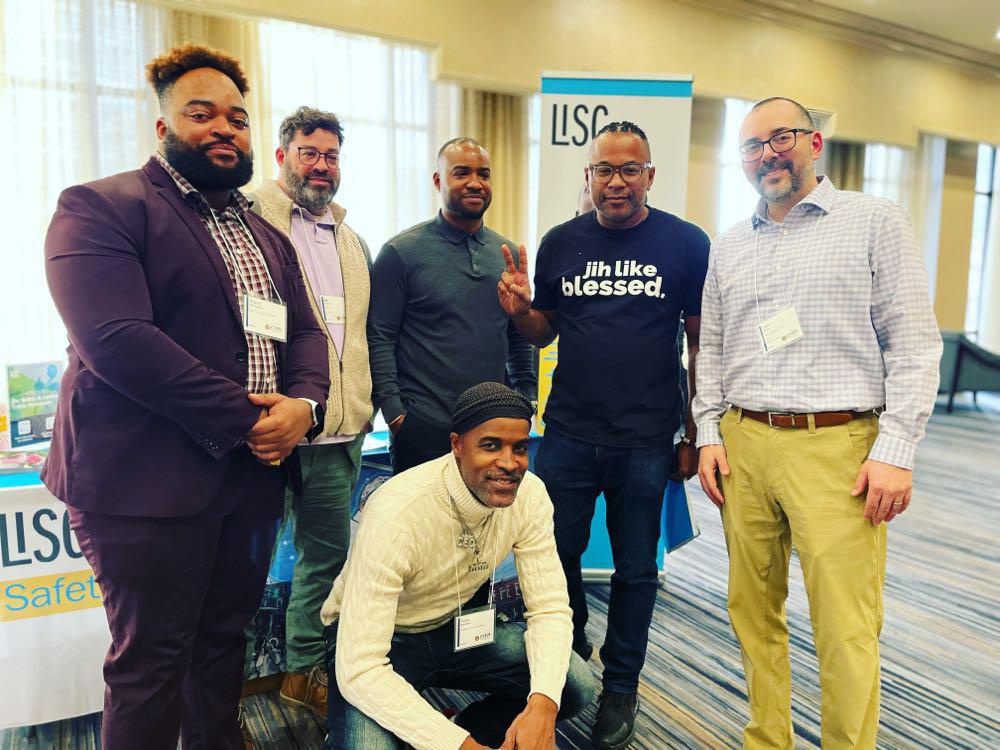
The excitement in the air was palpable on the kick-off day of the inaugural Community Based Violence Intervention and Prevention Initiative (CVIPI) Grantee Conference last month in St. Louis, MO. The conference-turned-family-reunion was filled with joy as colleagues and friends from a variety of violence interruption organizations had an opportunity to catch up.
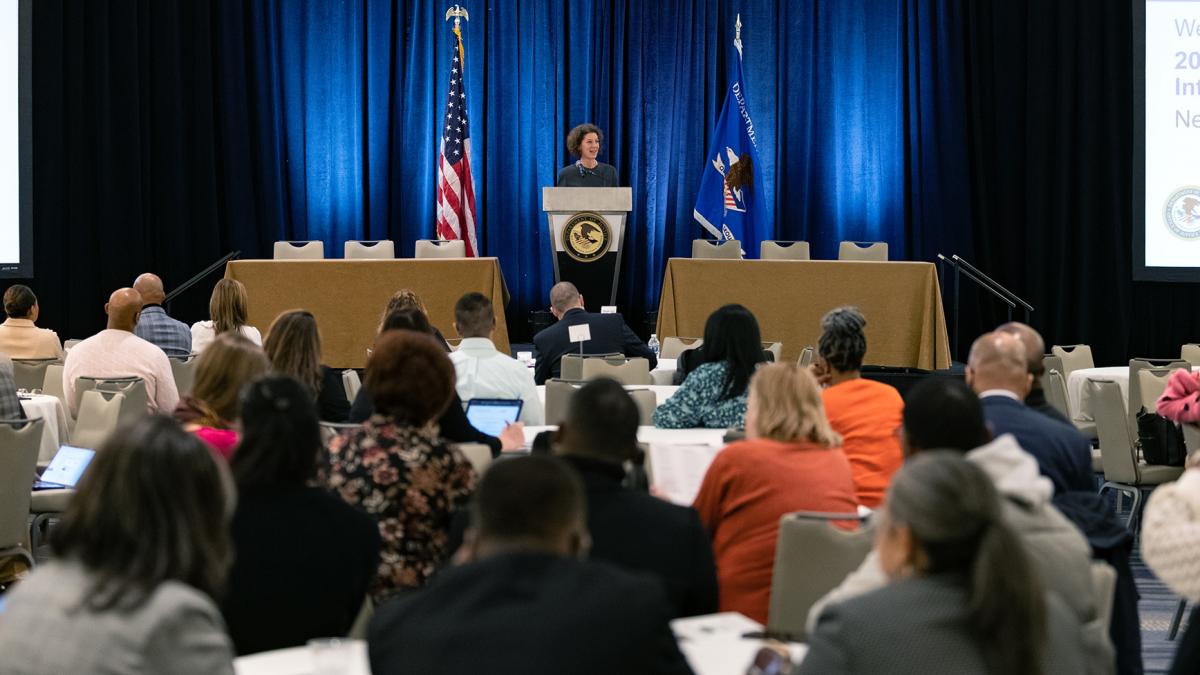
The 2023 CVIPI Grantee Conference brought together organizations that holding a federal grant to implement CVIPI-related tasks and activities. Grantee organizations include community-based organizations, research partners, district attorney and county probation offices, and public health organizations, among others. During the two-and-a-half-day conference, attendees heard from federal government leaders, including U.S. Attorney General Merrick B. Garland, who thanked the attendees for the work they are doing and acknowledged their collective goal:We are all here because we believe that everyone in this country deserves to feel safe in their communities. Every person, on every street, in every neighborhood, deserves to feel protected. Every parent, on every block, deserves to know that their children are safe when they play outside. Fulfilling that promise is our urgent shared challenge.
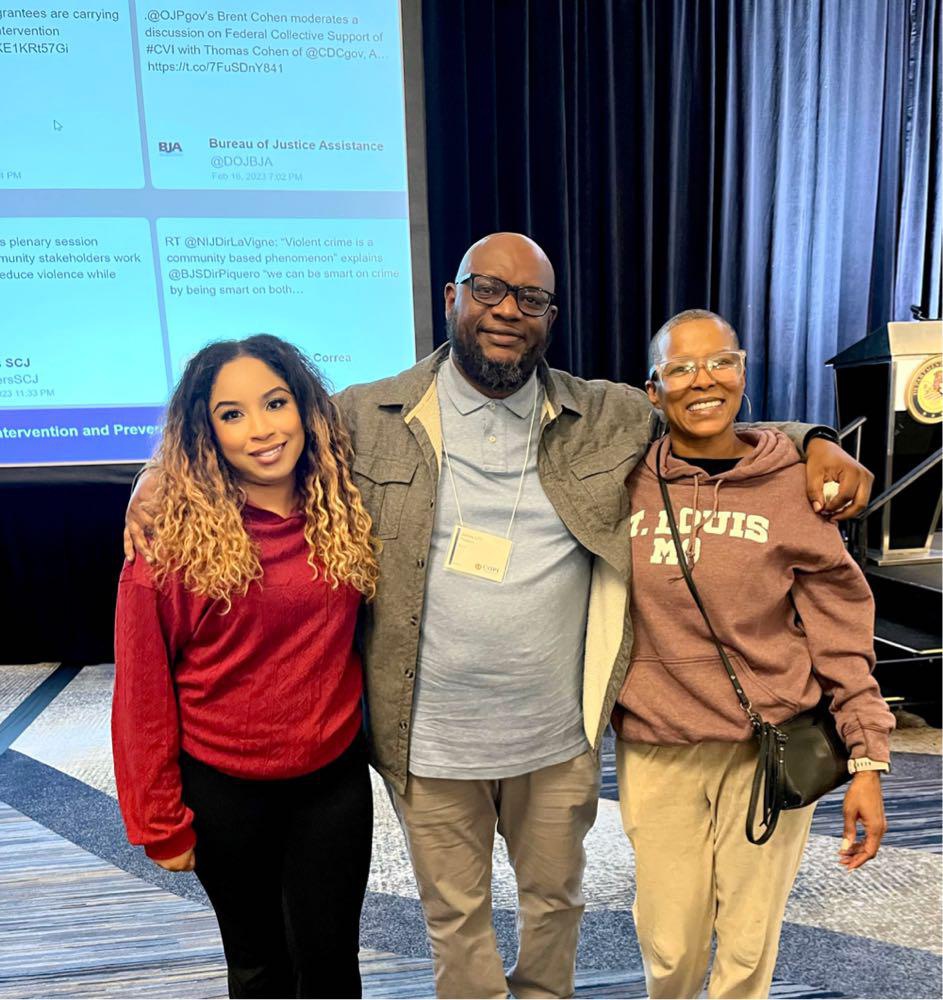
Although federal funding for community-based violence interruption is relatively new, many of the movers and shakers working on the ground within communities have been doing this work for years. Several leaders in the field of violence prevention shared their experiences and lessons learned through a recent webinar series and during breakout sessions at the conference. The wisdom and insights shared by these ”legends” deeply resonated with conference attendees, as evidenced by the robust conversations that continued well after each breakout session concluded.

Curious about what “community violence intervention” looks like? Check out these real-world examples:
Fifty-three organizations were selected as recipients of fiscal year 2022 CVIPI grant funds as part of $100 million allocated by the Biden-Harris Administration for disbursement by the Department of Justice to address gun violence through community violence intervention. While speaking at the conference, Attorney General Garland sparked a standing ovation when he announced that another $100 million would be available again this spring for fiscal year 2023. As promised, the Bureau of Justice Assistance recently released the FY 2023 CVIPI grant solicitation which will close on May 25, 2023.
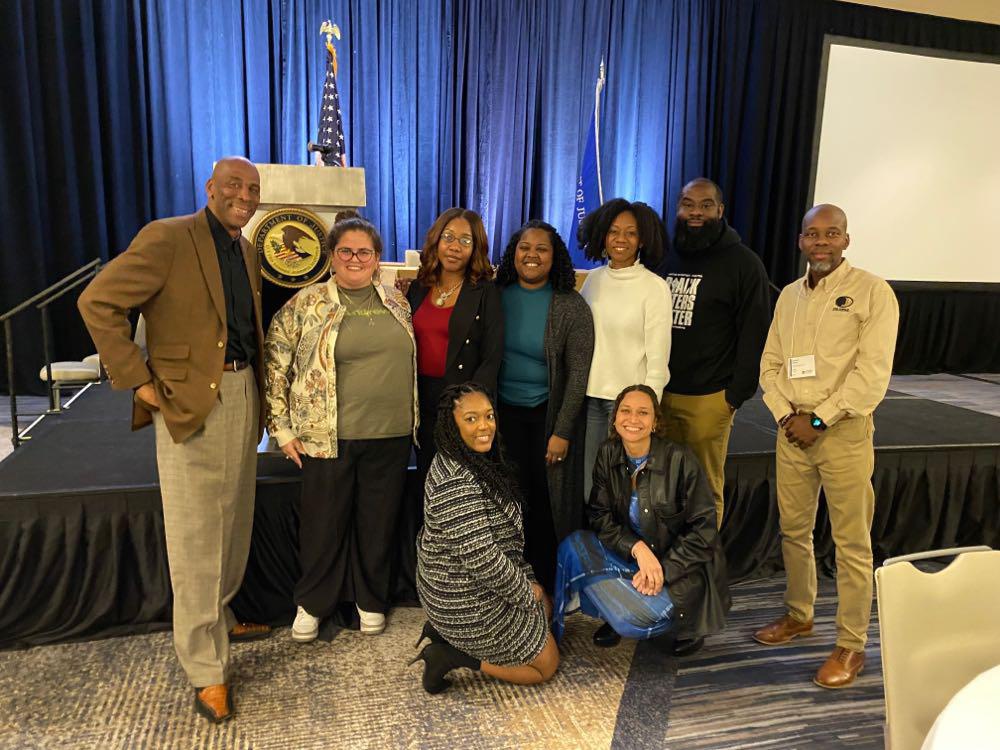
Is your agency or organization in need of training or technical assistance related to community violence intervention? Several of our TTA providers specialize in CVIPI, including the Urban Institute, LISC, and Travelers & Immigrants Aid’s Heartland Alliance for Human Needs & Human Rights. Request free training and technical assistance here.
In addition to many levels of Department of Justice leadership in attendance, several other leaders and organizations participated in the conference to provide their support, thought leadership, and inspiration to those working in the field, including:
- Police Commissioner Robert Tracy of the Metropolitan Police Department in St. Louis, MO
- Mayor Tishaura Jones of the City of St. Louis, MO
- Co-Executive Director Xavier McElrath-Bey
- Professor Reuben Miller of the University of Chicago
- Pacia Anderson, a Teaching Artist with Parable Arts
- Saroeum Phoung, Founder and CEO of PointOneNorth Consulting LLC
- Clinical Case Managers with the Life Outside Violence Program, Washington University in St. Louis
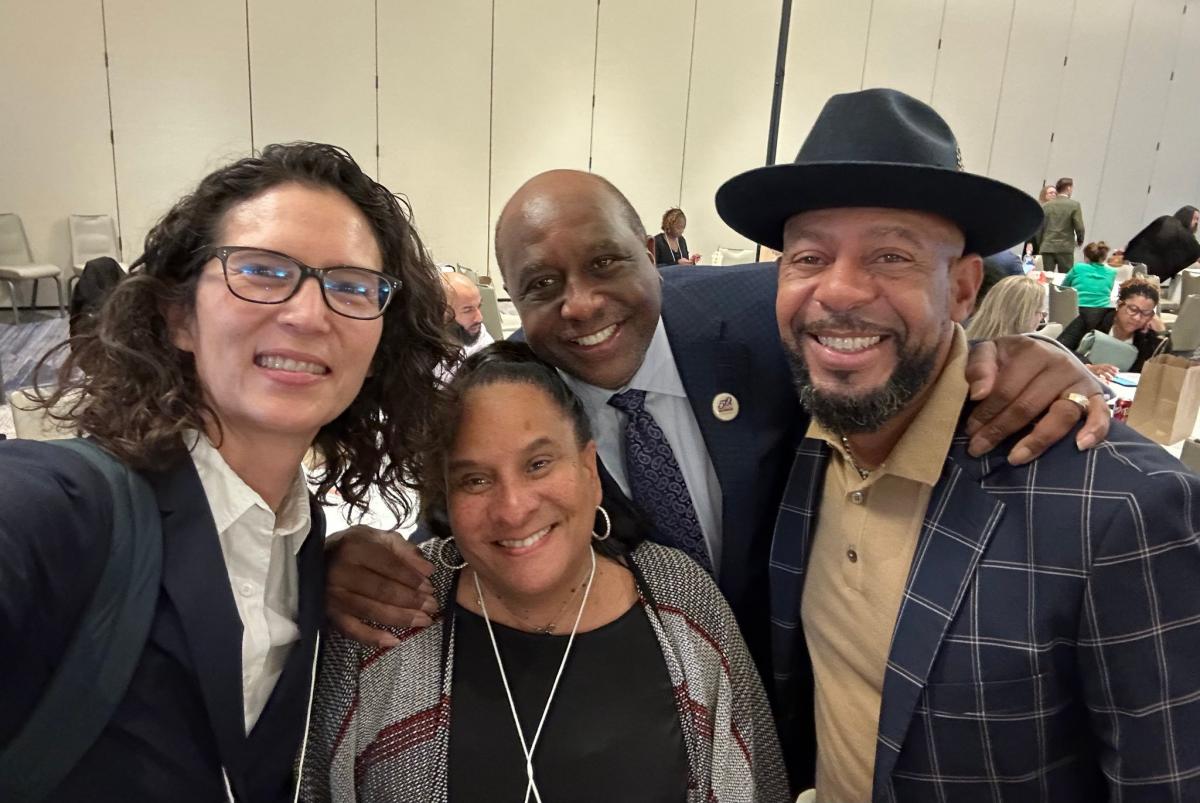
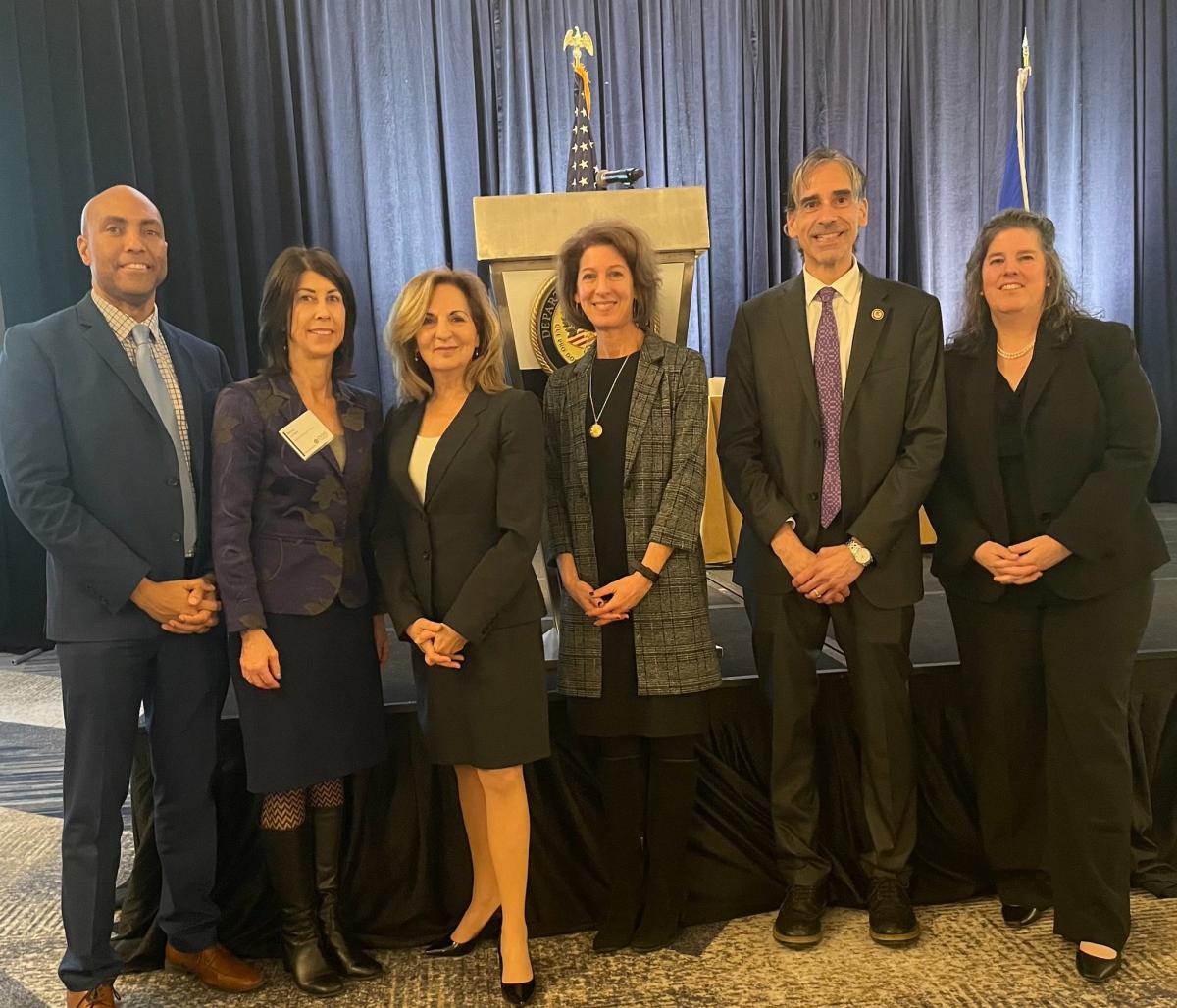
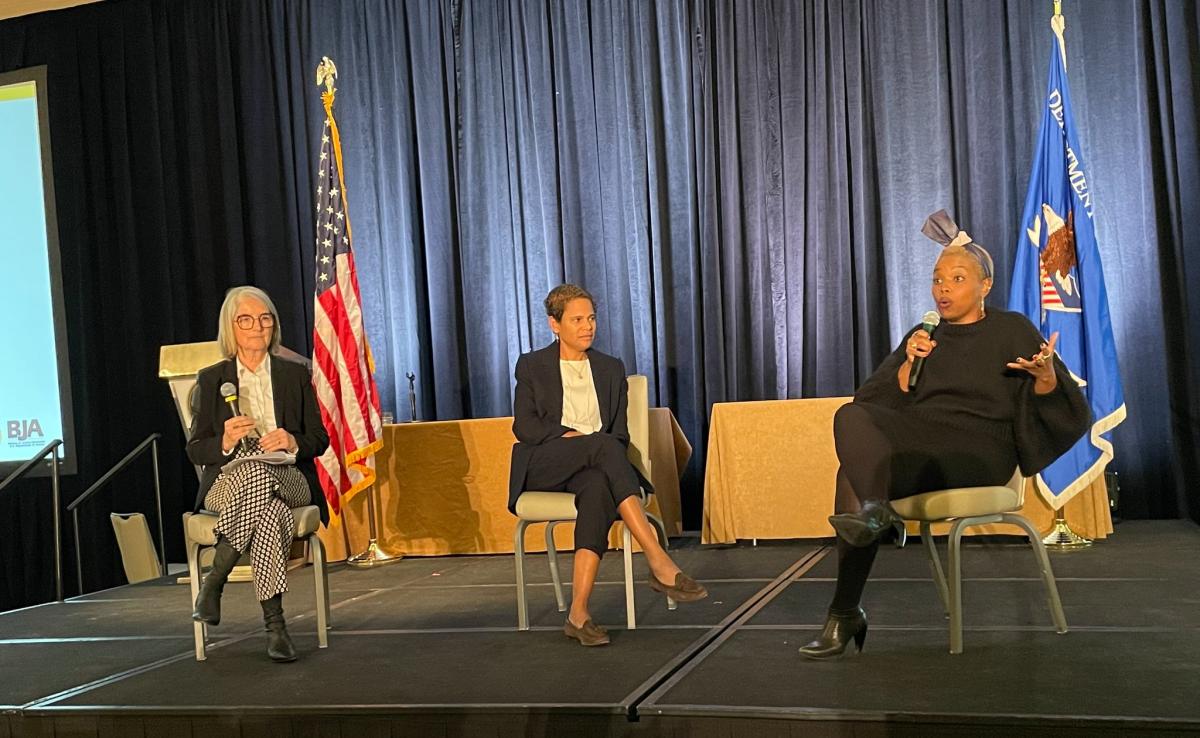
Related:
See what conference attendees had to say: #CVIStrengtheningCommunities - Twitter
Seven Trailblazers Addressing Community Violence Intervention Across the U.S. – Office of Justice Programs
What’s community violence intervention? DOJ pitches plan after awarding $100M in grants – USA Today
Justice Today podcast: Community Violence Intervention – Office of Justice Programs
Justice Department Awards $100 Million to Reduce Community Violence – Department of Justice
Associate Attorney General Vanita Gupta provides opening remarks at CVIPI Conference – Department of Justice
CVIPI Implementation Checklist – Bureau of Justice Assistance
Community Based Violence Intervention and Prevention Initiative Overview – Bureau of Justice Assistance
Community Based Violence Intervention and Prevention Initiative – Office of Justice Programs
*Applications are now closed.*
The U.S. Department of Justice (DOJ) established the National Public Safety Partnership (PSP) to provide an innovative framework to enhance federal support of state, local, and tribal law enforcement and prosecution authorities in building capacity to reduce violent crime. PSP is designed to promote interagency coordination by leveraging specialized law enforcement expertise with dedicated prosecutorial resources to promote public and community safety—with the end goal of reducing violent crime and making our communities safer places to live and work.
PSP’s strategic focus is to support communities that (1) struggle with sustained levels of violent crime far in excess of the national average and (2) would benefit from DOJ’s support in developing their own capacities.
PSP is a three-year commitment from DOJ to deliver no-cost customized site-specific training and technical assistance (TTA). PSP is not a grant program, and participating law enforcement agencies do not receive direct funding through this initiative. Agencies benefit from interacting with PSP network participants, learning from leading practitioners and academics, and accessing the many violence reduction tools and resources available to the sites. Please visit the PSP website at nationalpublicsafetypartnership.org to learn more about the initiative.
In 2023, DOJ will review potential candidates to join PSP. Interested jurisdictions should complete the TTA Request Form and Statement of Interest (application). Jurisdictions are encouraged to complete the Violent Crime Reduction Self- Assessment Tool. The assessment is optional and not required to submit your application for consideration. The PSP team will be notified once you submit your responses. (Results from this assessment will be reviewed by DOJ representatives.) The Violent Crime Reduction Operations Guide is also recommended for you to review. In consultation with U.S. Attorneys and DOJ law enforcement partners, sites will be selected through a quantitative and qualitative evaluation process. This process will consider, at a minimum, whether a jurisdiction:
- Has violent crime rates well above the national average.
- Is presently under-resourced in its capacity to drive down violent crime (special consideration may be given to rural jurisdictions).
- Has demonstrated readiness to participate in this collaborative initiative and coordinate efforts with the local Project Safe Neighborhoods (PSN) program.
- Is a mid-size or larger jurisdiction.
In addition, in making final selections, DOJ will consider geographic variety (to ensure representation from jurisdictions in different geographic regions with distinct characteristics; although jurisdictions of any size may apply and be considered) and the availability of DOJ resources to support the location. Please note that eligible applicants are limited to units of local government and federally recognized Indian Tribal governments that perform law enforcement functions (as determined by the Secretary of the Interior).
Please complete, sign, and submit the Training and Technical Assistance Request Form and Statement of Interest (application) by 11:59 p.m., ET, on May 12, 2023. Selected cities will be notified by June 15, 2023.
Apply here
If you have any questions, please email BJANTTAC@usdoj.gov.
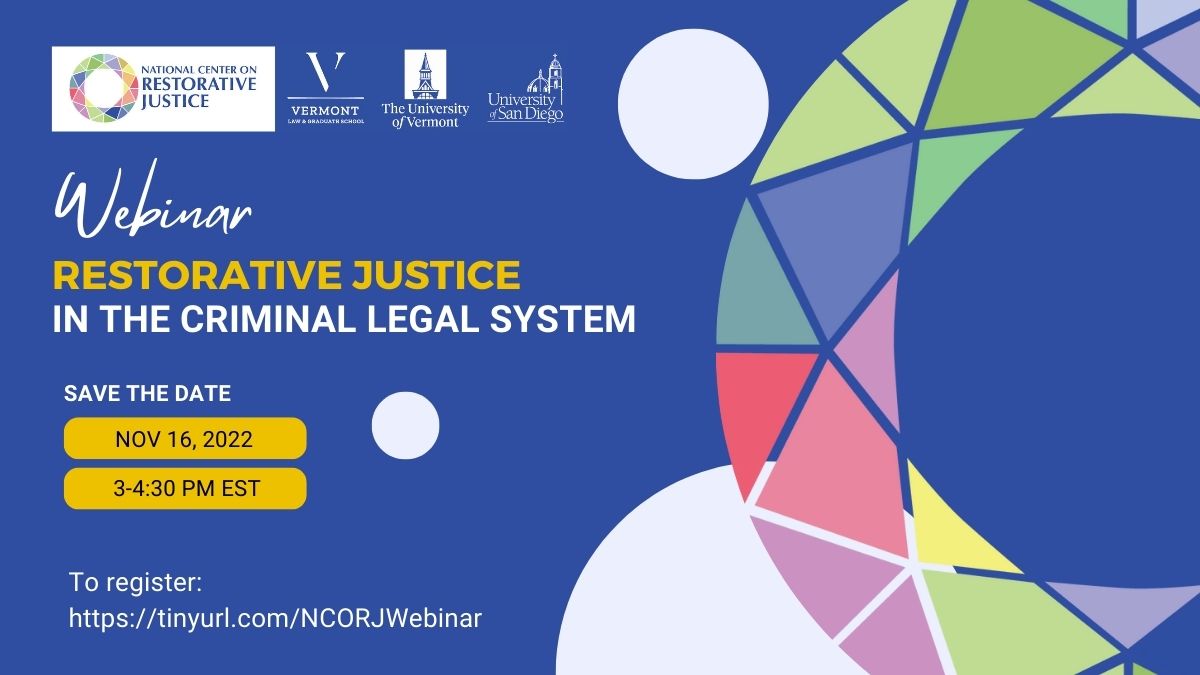
Do you ever wonder if there is another way to repair harm and think about accountability within our criminal legal system?
In honor of International Restorative Justice Week, the National Center on Restorative Justice (NCORJ) will offer a 90-minute webinar on restorative justice in the criminal legal system. The webinar is intended for justice system actors and others looking to learn more about restorative justice approaches and how to incorporate them into the justice system. Panelists will share how they implement restorative justice practices, the evidence of effectiveness and impact on the carceral system, and any challenges experienced during the implementation process.
The webinar will be on November 16, 2022, from 3:00-4:30pm ET.
In April 2021, the Biden-Harris Administration announced historic investments in community violence intervention (CVI) efforts to combat the gun violence epidemic. Please see the White House CVI Fact Sheet to learn more.
CVI Webinar Series
As part of the Administration’s efforts to support communities seeking to implement or expand CVI efforts, subject matter experts will present on CVI-related topics in a series of webinars. This webinar series is a joint effort of the U.S. Department of Justice, the U.S. Department of Health and Human Services, the U.S. Department of Housing and Urban Development, the U.S. Department of Labor, the U.S. Department of Education, and the White House Domestic Policy Council.
Part 1: Evidence-Based Theory and Research on CVI
In this webinar, presenters discuss immediate steps communities can take to reduce community violence as well as the social determinants of health (e.g., norms, policies) that can lead to inequities in violence. Within this framework, presenters define CVI, including the theory and research behind specific CVI models such as street outreach, violence interrupters, group violence interventions, and hospital-based interventions, as well as the role of the community and law enforcement within CVI.
Speakers include:
- Dr. Maury Nation, Professor, Department of Human and Organizational Development, Vanderbilt University
- Dr. Shani Buggs, Assistant Professor, Violence Prevention Research Program, University of California, Davis
- Dr. Deborah Gorman-Smith, Dean and Emily Klein Gidwitz Professor, Crown Family School of Social Work, Policy, and Practice, University of Chicago
View the recording and presentation slides to learn more.
Additional Resources:
- National Centers of Excellence in Youth Violence Prevention (YVPCs)
- Striving to Reduce Youth Violence Everywhere (STRYVE)
- Preventing Violence Affecting Young Lives (PREVAYL)
- CDC’s Firearm Violence Prevention Efforts
- CDC’s Youth Violence Prevention Efforts
- Prevention Institute: Community Safety Realized Final Report and Framework
Part 2: Place-based Approaches to CVI
In this webinar, presenters discuss community violence intervention efforts in the context of a place-based approach. Framed in the social ecological model, place-based approaches can reduce and prevent community violence and crime by enhancing and maintaining the physical characteristics of settings where people come together in order to foster social interaction, strengthen connectedness, and increase collective efficacy (e.g., shared trust among residents and willingness to intervene). Presenters will highlight the importance of community engagement within place-based approaches and discuss how incorporating community revitalization efforts, such as increasing green spaces and addressing abandoned buildings can reduce and prevent community violence.
Speakers include:
- Dr. Catherine Bradshaw, Professor; Associate Dean for Research and Faculty Development, School of Education and Human Development, University of Virginia
- Meisha Mitchell. AICP, PP, Vice President, Camden Community Partnership
- Donna Griffin, President, Community Capacity Builders
- Dr. Eugenia C. South, Assistant Professor, School of Medicine, University of Pennsylvania
View the recording and presentation slides to learn more.
Additional Resources:
- CDC Social Ecological Model: A Framework for Violence Prevention
- CDC’s Youth Violence Technical Package
- CDC’s Crime Prevention Through Environmental Design)
- VetoViolence: Violence Prevention in Practice | Create Protective Community Environments
- National Centers of Excellence in Youth Violence Prevention (YVPCs):
- Vacant Land Online Resource Center (ORC).
Part 3: CVI In Practice
In this webinar, leading CVI experts share their on-the-ground experiences on how to implement CVI strategies within communities. They share insights on what communities should consider in order to effectively implement and sustain CVI efforts.
Speakers include:
- Anthony Smith, Executive Director, Cities United
- Fatimah Loren Dreier, Executive Director, Health Alliance for Violence Intervention (HAVI)
- Anne Marks, Executive Director, Youth ALIVE!
- Ray Winans, Executive Director, Detroit Life is Valuable Everyday (D.L.I.V.E)
View the recording and presentation slides to learn more.
Additional Resources:
- CDC Violence Prevention Technical Package Implementation Guidance
- STRYVE: Tools and Trainings
- VetoViolence: Violence Prevention in Practice - Street Outreach and Community Norm Change
- The Cardiff Violence Prevention Model
- NIH OBSSR Director's Webinar: Behavioral Health and Injury Prevention: The Emergency Department as a Window to Community and Population Health
- NIH OBSSR: Violence Research Initiatives
- FACTS Consortium
Part 4: Community-Centered Evaluation
In this webinar, leading experts in program evaluation discuss partnerships and evaluation, including process and outcome evaluations, and ways to partner on evaluation in order to understand whether CVIs are working to reduce community violence. The webinar also covers the benefits of Participatory Action Research, a community-centered strategy that involves partnering with a researcher in an iterative process of program development and improvement. The webinar will include information about a wide range of research and evaluation tools and resources for practitioners.
Speakers include:
- Dr. Caterina Roman, Professor, Department of Criminal Justice at Temple University
- Dr. Barbara Israel, Professor of Health Behavior & Health Education, Director of Detroit Community-Academic Urban Research Center, University of Michigan School of Public Health
- Roseanna Ander, Founding Executive Director of the University of Chicago Crime Lab and Education Lab
- Eduardo (Eddie) Bocanegra, Senior Director, Heartland Alliance READI Chicago
View the recording and slides to learn more.
Additional Resources:
- CDC Framework for Program Evaluation
- VetoViolence: EvaluACTION
- CDC/ATSDR Models and Frameworks for the Practice of Community Engagement
- OBSSR’s Funded Training on CBPR:
- CBPR Partnership Academy | Detroit Urban Research Center (detroiturc.org)
- NIH’s Community-Based Participatory Research Program
Additional Resources
By NTTAC Communications
In recent weeks, the topic of mass violence has weighed heavily on our hearts and minds. As we mourn lives lost and provide support to grieving families and communities, law enforcement agencies and other public safety partners must also turn their attention to planning and preparation to ensure that they are response-ready should tragedy strike again.
There is a broad range of resources available to agencies and communities as they assess their situational readiness and develop comprehensive emergency response plans. In the event of a mass casualty incident, there are several helpful tools to guide response to the immediate, short-term, and ongoing needs of victims and responders. There are also federal funding sources to support response and recovery. The resources we’ve identified below will be helpful as you review your agency and/or community action plans:
Planning and Response
- The International Association of Chiefs of Police (IACP) Law Enforcement Policy Center’s Active Shooter Model Policy and Issues Paper provides concrete guidance and directives, as well as context and background information, and includes protocols for assessing the threat and immediately responding during active shooter situations to limit serious injury or loss of life. While the term “active shooter” is used throughout, the guidance applies to all situations where there is an active assailant or assailants posing an ongoing deadly threat.
- Developed by the RAND Corporation through funding from the National Institute of Justice (NIJ), the Mass Attacks Defense Toolkit was created to help reduce the likelihood of mass shootings and other public attacks and reduce the casualties of completed attacks. Based on analysis of over 600 mass attack events and plots, researchers describe the most important tips they found to help reduce the likelihood and casualties of attacks. They also point to key guidance and resources for agencies in need of comprehensive information as they build out their own plans.
- The IACP and the Childhood Violence Trauma Center at the Yale School of Medicine, with support from the Office of Juvenile Justice and Delinquency Prevention (OJJDP), have developed Enhancing Police Responses to Children Exposed to Violence: A Toolkit for Law Enforcement. This comprehensive toolkit includes assessment and operational tools, sample protocols, and online training modules.
- The National Sheriffs’ Association’s NSA School Safety Resource Site includes recorded webinars, training opportunities, and resource links.
- The Casualty Care Toolkit, developed through BJA’s VALOR Officer Safety and Wellness Program (VALOR Program), equips law enforcement officers with the essential tools and knowledge to save lives in the field through effective casualty care techniques. Based on the Tactical Combat Casualty Care guidelines, which are utilized by all U.S. military Special Forces medics and medically trained soldiers, the toolkit contains demonstration videos, printable resources, and roll-call drills.
- Helping Victims of Mass Violence and Terrorism: Planning, Response, Recovery, and Resources, developed by the Office for Victims of Crime (OVC), provides tools and resources for developing a comprehensive victim assistance plan that can be incorporated into a community’s existing emergency response plan.
- CNA and NSA developed a toolkit that provides a step-by-step plan for conducting an active shooter incident response exercise on a military installation. The Active Shooter Exercise Kit includes conduct slides, facilitator guides, participant handbooks, and a summary report template.
- The Bureau of Justice Assistance (BJA) and the IACP have partnered to launch the Mass Violence Advisory Initiative (MVAI), which provides peer-to-peer assistance to law enforcement leaders following a mass violence tragedy to maximize the safety and wellness of officers, other first responders, and the community.
- After any critical incident, reflection and review are critical to identifying gaps and strengthening future response. After action reports for several mass shootings in recent years are available on the IACP’s website here.
Emergency Funding
- The Emergency Federal Law Enforcement Assistance (EFLEA) Program, administered by BJA, assists states and/or local units of government in responding to extraordinary law enforcement emergencies through grant funding to help alleviate costs, such as overtime, incurred by law enforcement during response. Congress’ intent for the EFLEA Program was to create an assistance program that addresses extraordinary circumstances with the potential to generate serious threats to public safety. The two-step application process following a law enforcement emergency begins with a letter from the State Administering Agency (SAA) Edward Byrne Memorial Justice Assistance Grant (JAG) contact for the affected state, acting on behalf of the chief executive officer for the state, to the BJA Director. BJA evaluates EFLEA Program applications based on the likelihood that a situation could escalate into a law enforcement emergency of epidemic proportion and subsequently pose an imminent threat to public safety. The emergency must be of sufficient magnitude to overwhelm a state or local government’s ability to respond. If the request is approved, the SAA JAG contact will be invited to submit a formal application and will be provided with written guidance on how to apply.
- OVC supports communities responding to terrorist attacks and mass violence through its Antiterrorism and Emergency Assistance Program (AEAP). The AEAP offers four grant funding streams to provide timely relief for immediate and ongoing victim assistance services to qualified applicants: crisis response, crime victim compensation, consequence management, and criminal justice support. Qualified applicants include state victim assistance and compensation programs; public agencies, including federal, state, and local governments; federally recognized Indian tribal governments; U.S. Attorneys’ Offices; public institutions of higher education; and nongovernmental and victim service organizations. AEAP grants are available by OVC invitation only. Shortly after an event, OVC will contact officials in the state or jurisdiction where the incident occurred to discuss the scope of the victims’ needs and explain what resources may be available.
Recovery
- The Office for Victims of Crime’s The Vicarious Trauma Toolkit (VTT) was developed on the premise that exposure to the traumatic experiences of other people—known as vicarious trauma—is an inevitable occupational challenge for the fields of victim services, emergency medical services, fire services, law enforcement, and other allied professionals; however, organizations can mitigate the potentially negative effects of trauma exposure. The VTT includes tools and resources, tailored specifically to these fields, that provide the knowledge and skills necessary for organizations to address the vicarious trauma needs of their staff.
- Preparing For The Unimaginable offers expert advice and practical tips for helping officers to heal emotionally, manage the public, deal with the media, and build relationships with other first responder agencies after a mass violence incident. The publication was created by the National Alliance on Mental Illness (NAMI) and Community Oriented Policing Service (COPS) Office based on their work with the Newtown (Connecticut) Police Department after the Sandy Hook Elementary School Shooting.
- The Public Safety Officers' Benefits Program (PSOB) provides death and education benefits to the survivors of fallen law enforcement officers, firefighters, and other first responders, and disability benefits to officers catastrophically injured in the line of duty, including as a result of participating in response efforts to large-scale incidents.
We encourage your agency to revisit existing response protocols regularly, revising as necessary. Dealing with a mass casualty incident is never easy for responders or for the affected community; however, through planning, preparation, and practice, you can help mitigate the impact of trauma, not only to victims and their families, but to your first responders. As always, BJA NTTAC stands ready to assist communities as they develop and revise their emergency plans and address other public safety concerns.
If your jurisdiction needs training or technical assistance, please contact BJA NTTAC at BJANTTAC@ojp.usdoj.gov and we can connect you to the appropriate training, assistance, TTA partner, and/or resources.
If you are interested in submitting the work of your organization or jurisdiction for consideration in a future TTA blog post, please email us at BJANTTAC@ojp.usdoj.gov.
Points of view or opinions on BJA NTTAC’s TTA blog are those of the author(s) and do not necessarily represent the official position or policies of the U.S. Department of Justice, BJA, or BJA NTTAC.
* Applications have closed. *
The U.S. Department of Justice (DOJ) is accepting applications for the National Public Safety Partnership (PSP). PSP serves as a U.S. DOJ-wide initiative that enables cities experiencing high rates of violent crime to partner with DOJ and to receive intensive, coordinated training and technical assistance (TTA) from DOJ to support and enhance public safety and community violence intervention (CVI) strategies.
DOJ is committed to advancing work that promotes civil rights, increases access to justice, supports crime victims, protects the public from crime and evolving threats, and builds trust between law enforcement and the community. The PSP initiative supports and advances DOJ’s principles in all of its activities.
PSP offers cities the opportunity to take advantage of:
- Three years of formal engagement, coordinated through the Bureau of Justice Assistance, to support DOJ’s commitment to and partnerships with jurisdictions on building capacity, increasing collaboration, and sharing promising practices in a variety of public safety areas
- Needs-based strategic assessments to support your city's violent crime prevention and community engagement efforts
- Access to subject-matter expert consultation and customized TTA
In 2022, DOJ will review potential candidates to join the Partnership. Interested jurisdictions should complete the Training and Technical Assistance Request Form and Statement of Interest by 11:59 p.m., ET, on Friday, July 15, 2022. Application submission information is available in the application. Sites will be selected through a quantitative and qualitative evaluation process, in consultation with U.S. Attorneys and DOJ law enforcement partners. This process will consider, at a minimum, whether a jurisdiction:
- Has violent crime rates well above the national average;
- Is presently under-resourced in its capacity to drive down violent crime (special consideration may be given to rural jurisdictions)
- Has demonstrated readiness to participate in this collaborative initiative.
* Applications have closed. *
By Moe McClanahan, High-Tech Crime Specialist, National White Collar Crime Center
One emerging cyber threat that can impact individuals, including law enforcement officers, other criminal justice practitioners, and their families, is doxing. Doxing occurs when someone’s personal information is discovered and maliciously exposed online. This can include uncovering someone’s real name, home address, place of employment, and other personal information. It is important to ensure that apps, browsers, and devices are set in a way that minimizes the risk of compromise.
Our digital footprint consists of a plethora of personal data and it is important to ensure that daily digital activity is done as securely as possible. Doxing can happen across a wide variety of frequently visited applications and browsers as well as various devices with different operating systems. This can include Android and iOS operating systems, Google Chrome, Internet Explorer, various social media applications, and more.
Results of a study done by NYU Tandon School of Engineering found that more than 90 percent of the doxed files included the victim's address, 61% included a phone number, and 53 percent included an email address. While less common, sensitive information, such as credit card numbers (4.3 percent), Social Security numbers (2.6 percent), or other financial information (8.8 percent), were also revealed.
The National White Collar Crime Center (NW3C) recently released free officer cybersafety training that provides step-by-step instructions for securing apps, browsers, and devices. Some of the popular apps covered include Amazon, Bumble, Facebook, LinkedIn, TikTok, and Twitter. The training on browsers includes Google Chrome, Mozilla Firefox, Internet Explorer, Microsoft Edge, and Opera. Lastly, it covers both Android and iOS devices.
Each officer cybersafety microlearning module takes no more than 10 minutes to complete. Users can follow along with the step-by-step security instructions by having the app, browser, or device available during the training. Modules are routinely updated to keep up with evolving technology, so check back often.
To learn more about NW3C’s cyber safety learning modules as well as other courses, view our training selection list here.
NW3C has developed and delivered economic crime investigation, high-tech crime investigation, digital forensics, criminal intelligence, and other criminal justice training and technical assistance to law enforcement, prosecutors, and other criminal justice practitioners since 1978. Through various research experts, partnerships, and curriculum developers, NW3C has developed industry-leading training that has been delivered to over 100,000 criminal justice practitioners nationwide.
NW3C's officer cybersafety microlearning modules are funded by the Bureau of Justice Assistance.
If your jurisdiction is in need of training or technical assistance related to pretrial assessment tools, or if you know of a community that would benefit from this type of assistance, please contact BJA NTTAC at BJANTTAC@ojp.usdoj.gov and we can connect you to the appropriate training, assistance, TTA partner, and/or resources.
If you are interested in submitting the work of your organization or jurisdiction for consideration in a future TTA Today blog post or in obtaining information related to a particular topic area, please email us at BJANTTAC@ojp.usdoj.gov.
Points of view or opinions on BJA NTTAC’s TTA Today blog is those of NW3C and do not necessarily represent the official position or policies of the U.S. Department of Justice, BJA, or BJA NTTAC.
Last month, the Bureau of Justice Assistance (BJA) published a legal guide describing the significance of substance withdrawal supervision in jails and the laws protecting people in jails. According to the Bureau of Justice Statistics (BJS), 63 percent of incarcerated adults have substance use disorders, compared to 5 percent of adults who are not incarcerated. This brief describes the scope of the challenge, provides an overview of constitutional rights and key legislation related to substance use withdrawal, and outlines steps for creating a comprehensive response to substance use disorders.
To read more on substance use disorder awareness in jails, access Managing Substance Withdrawal In Jails: A Legal Brief.